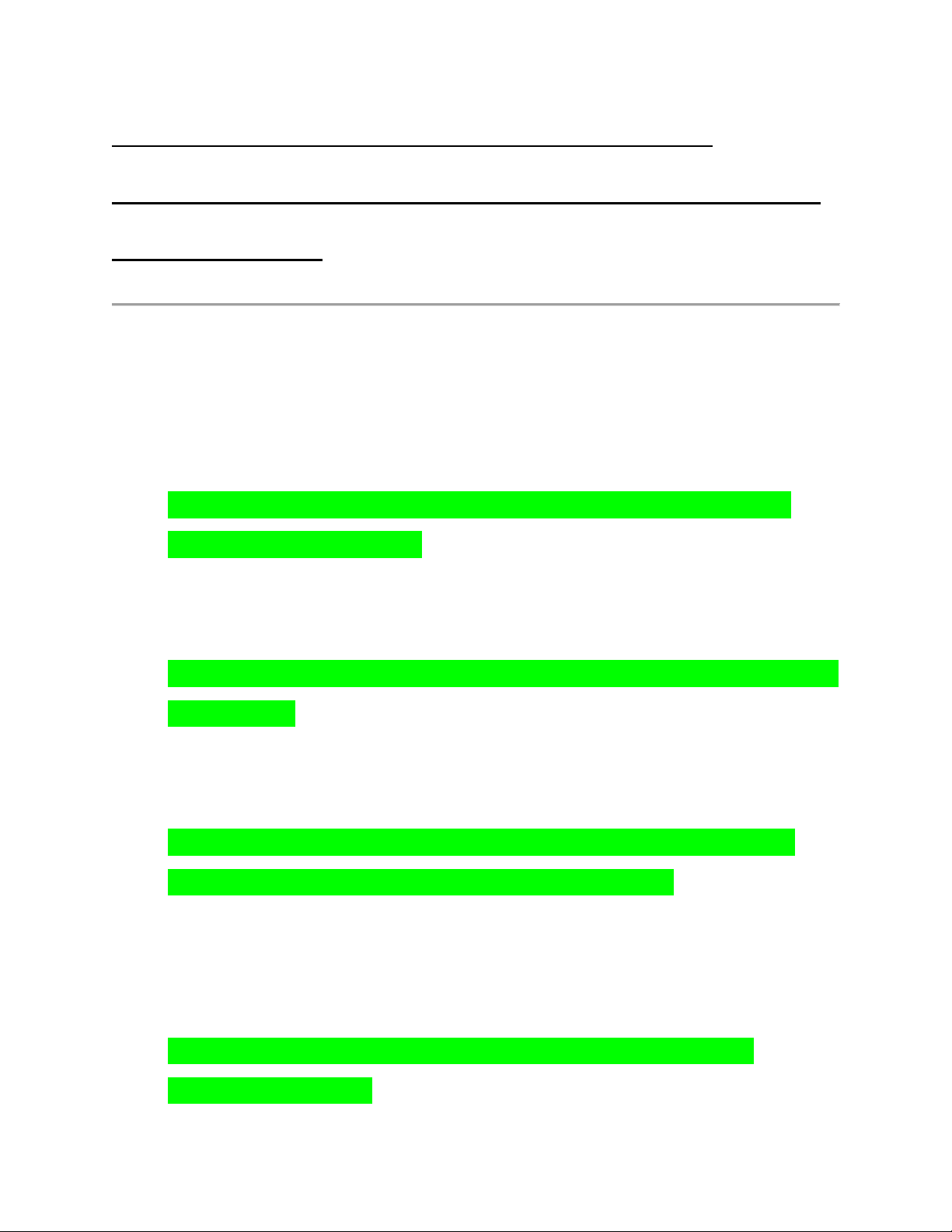
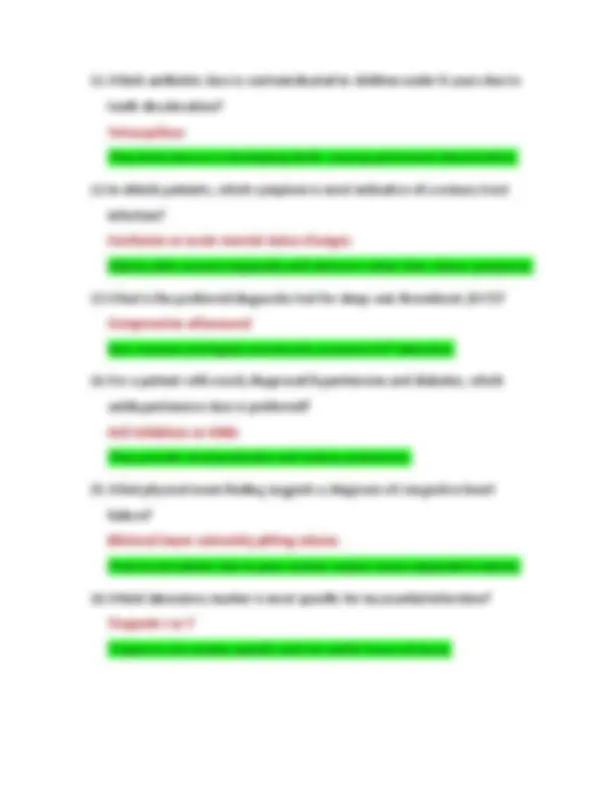
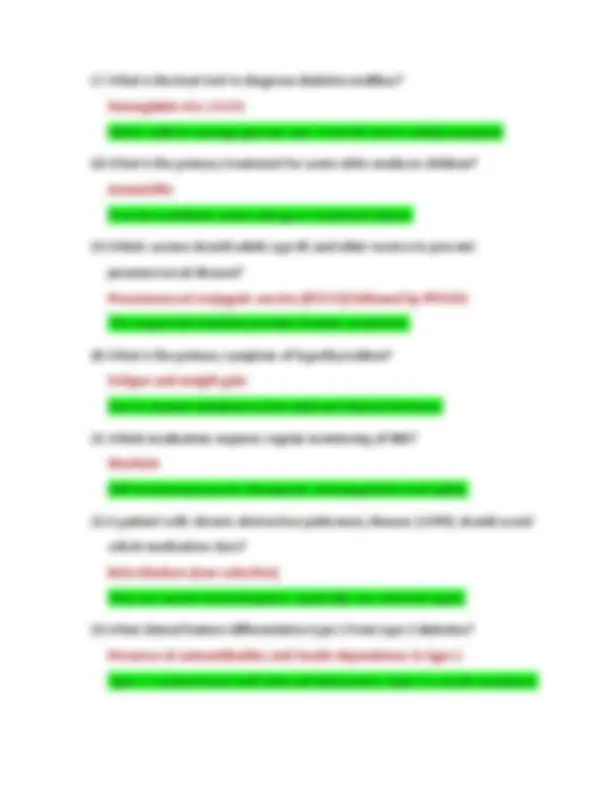
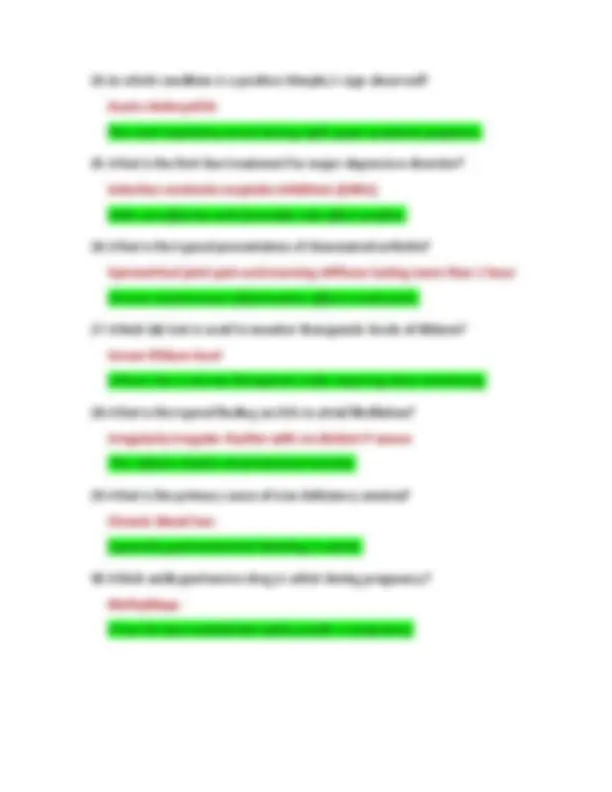
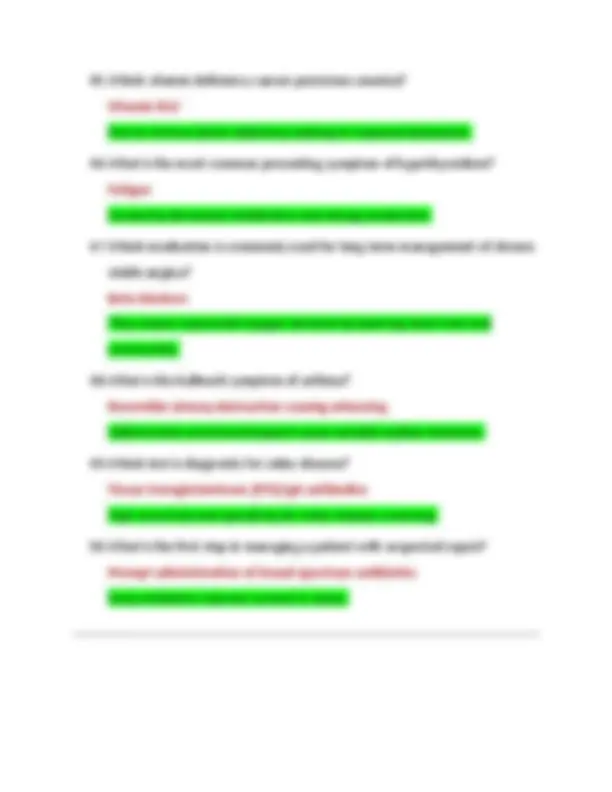
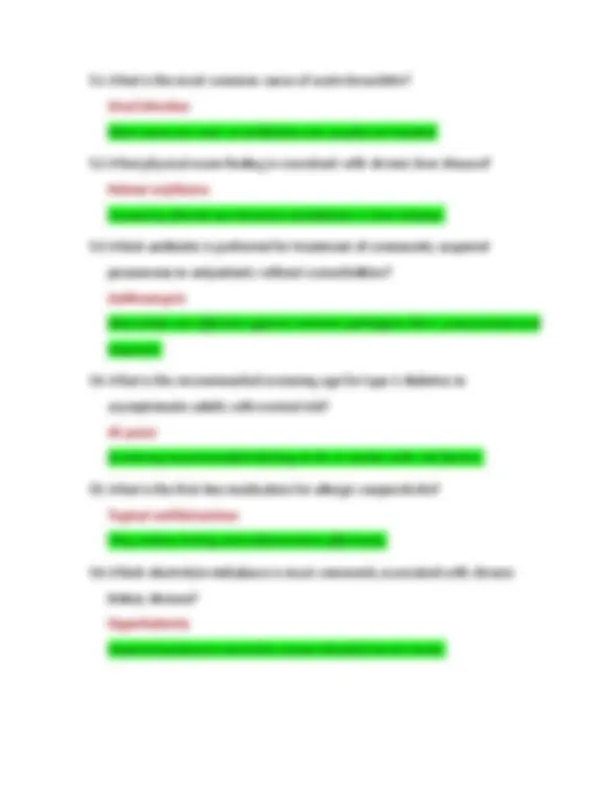

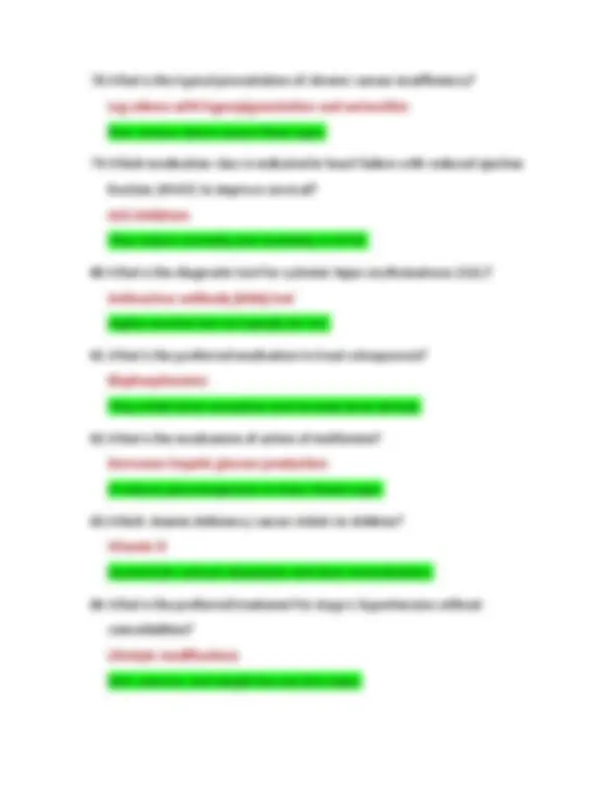
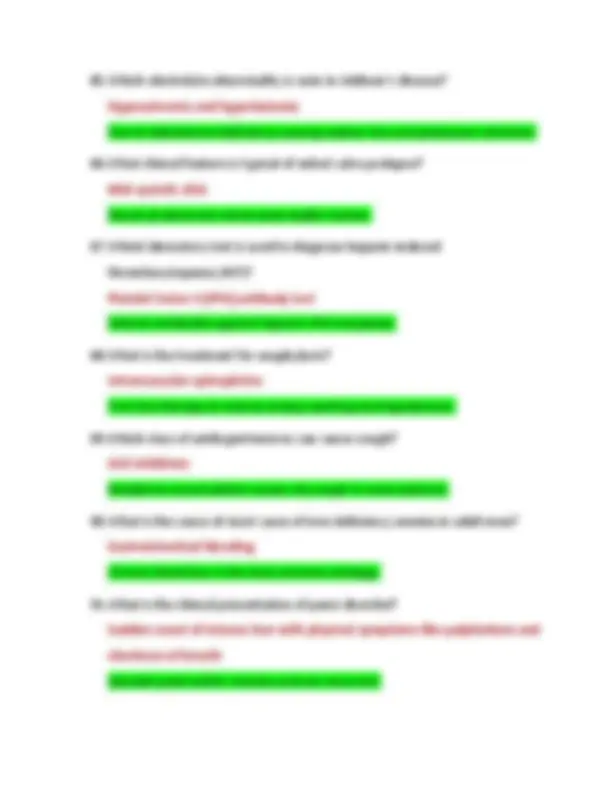
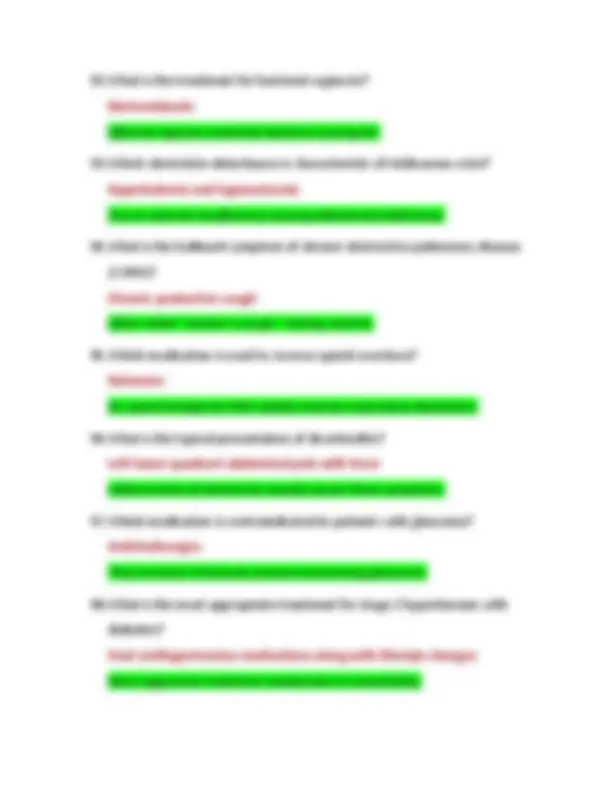
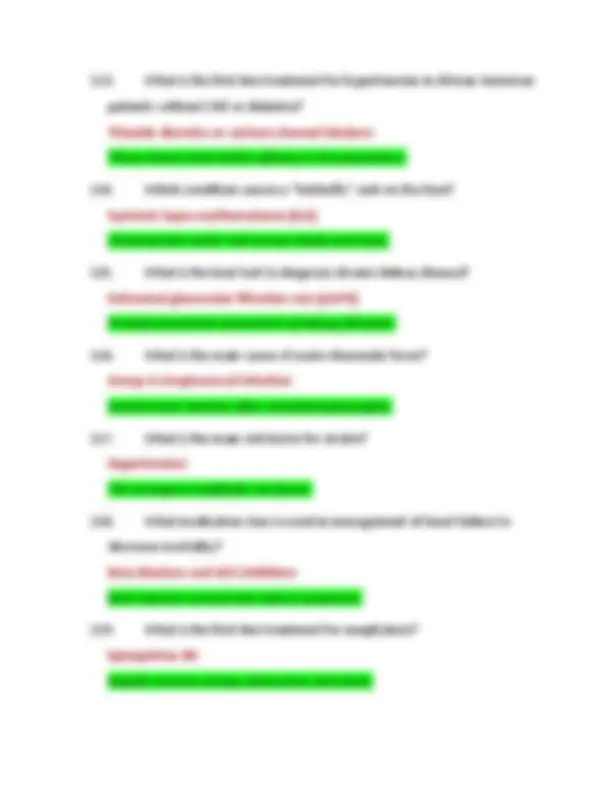
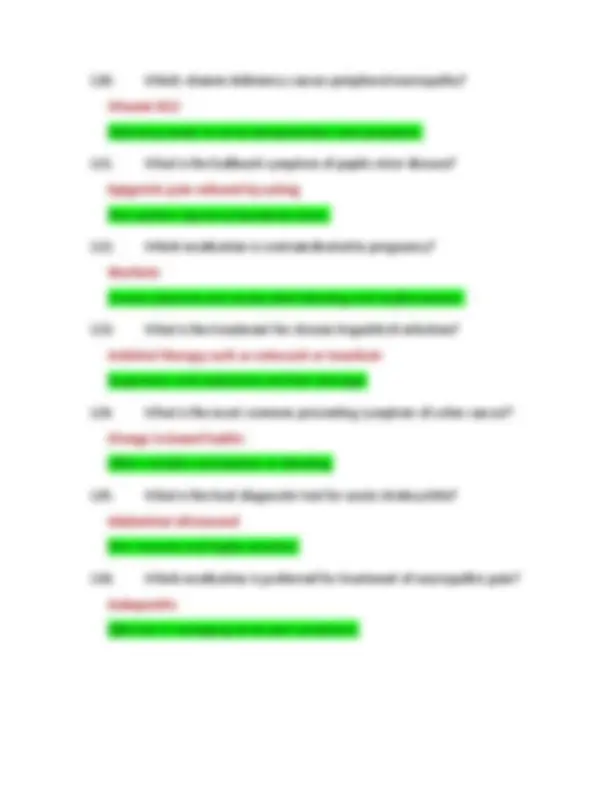
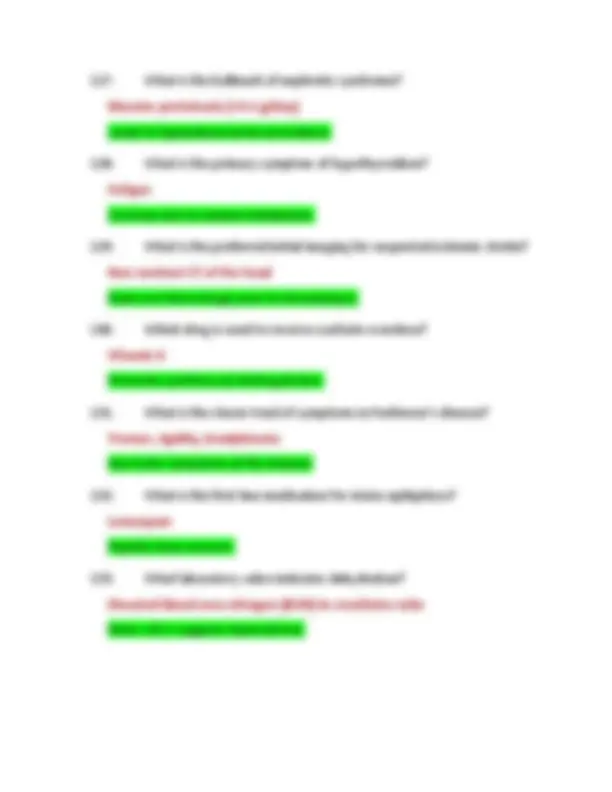
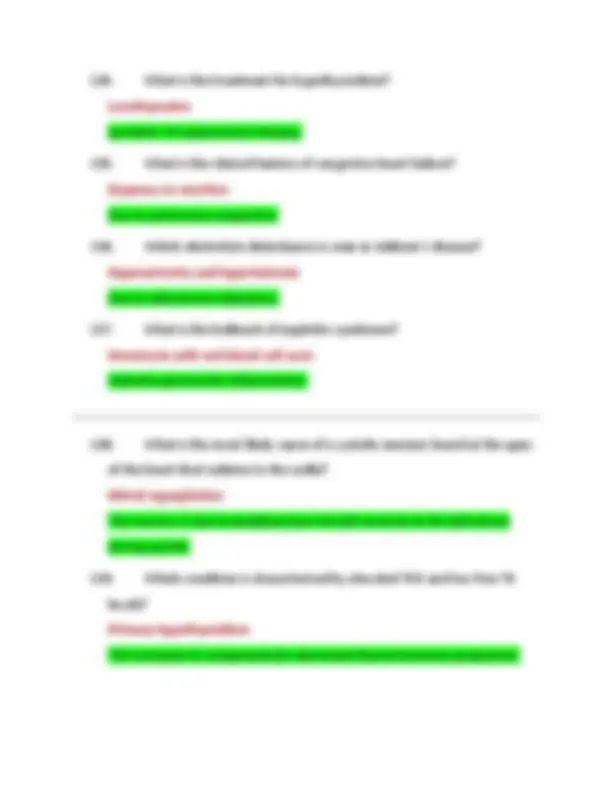
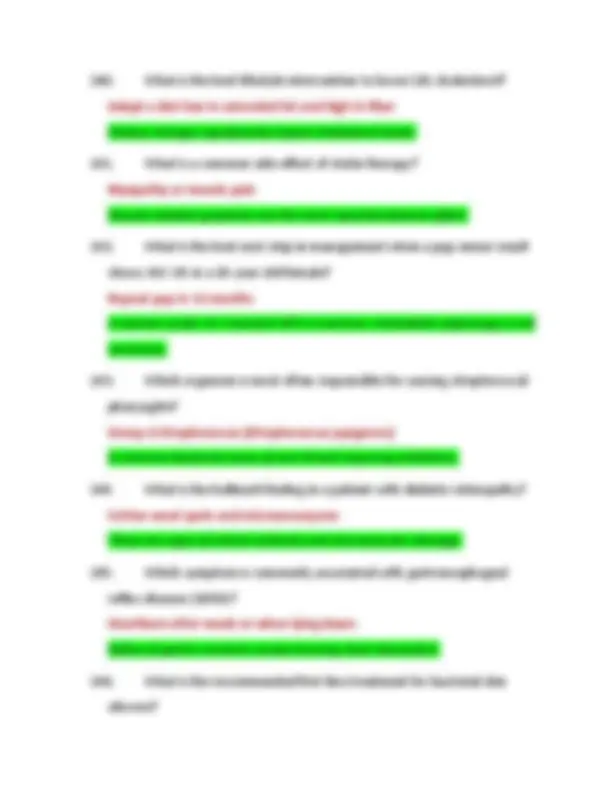

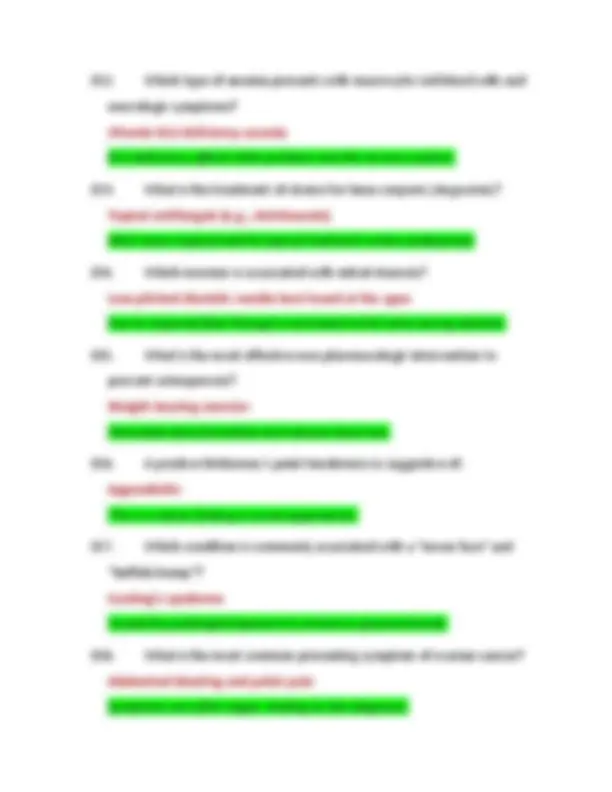
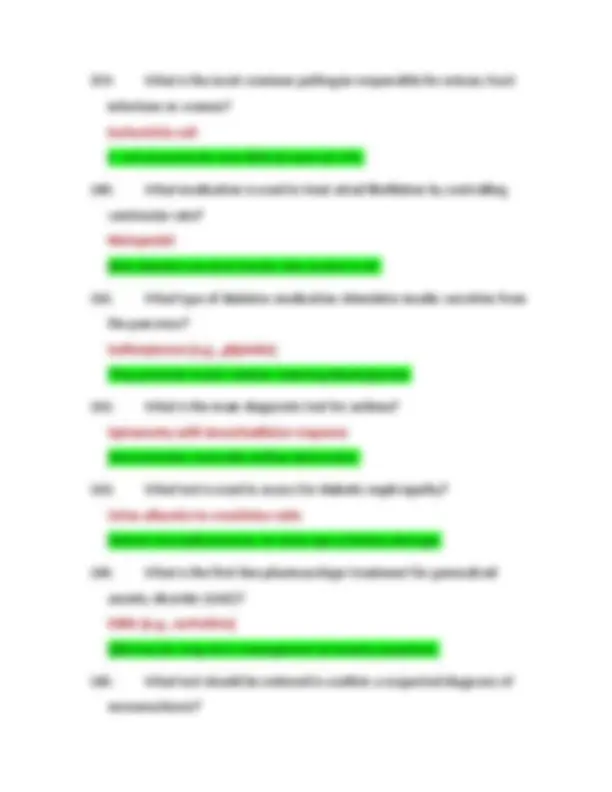
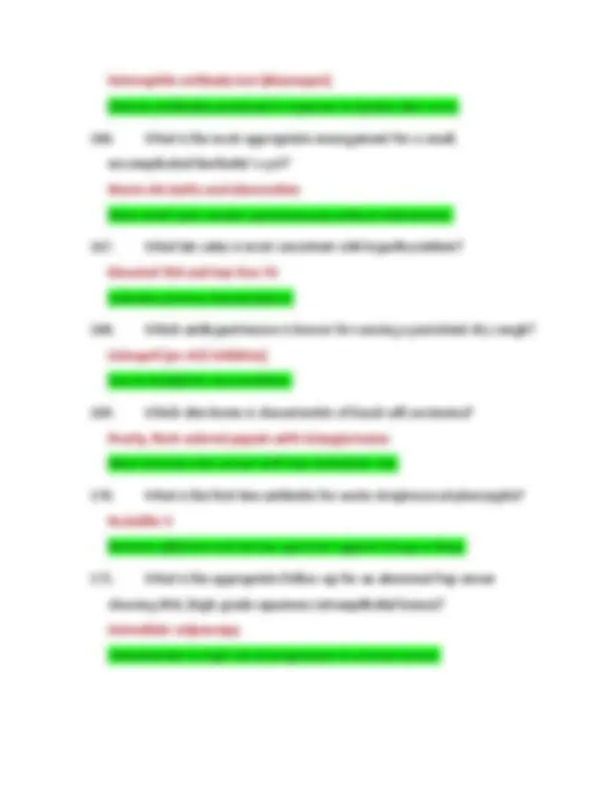
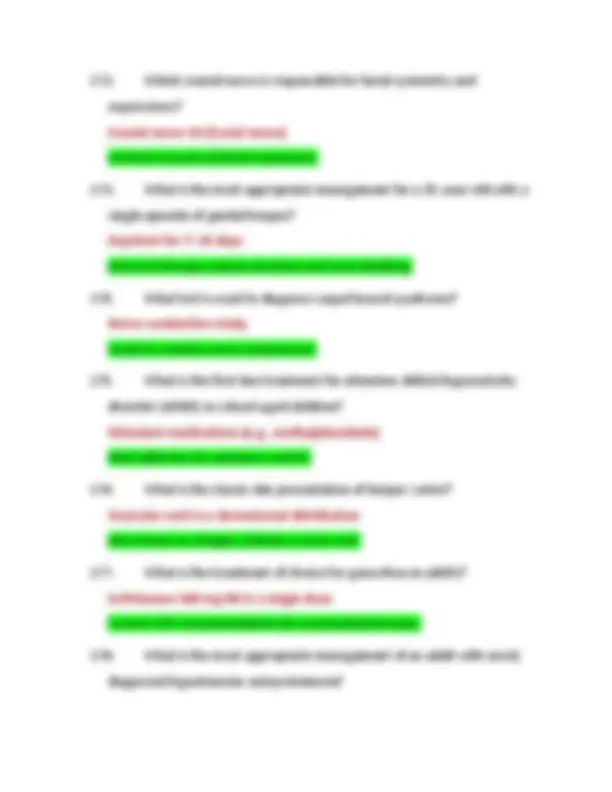
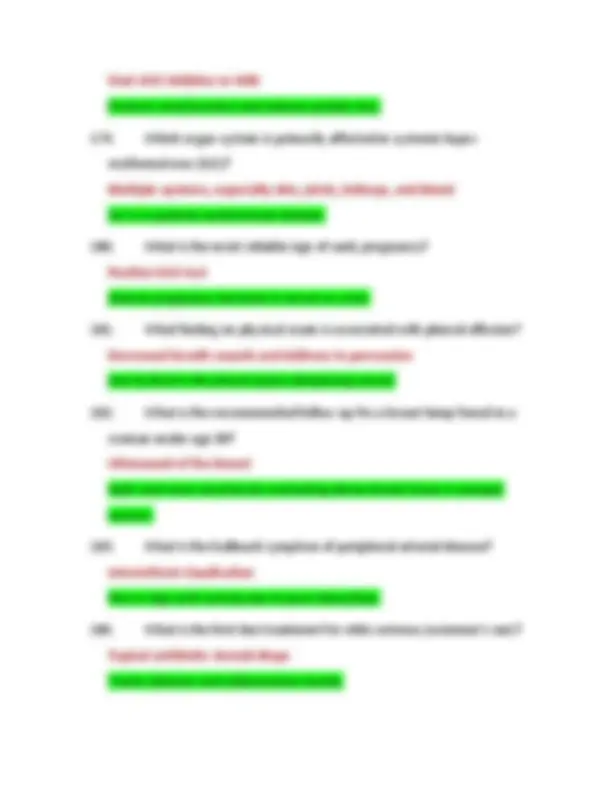
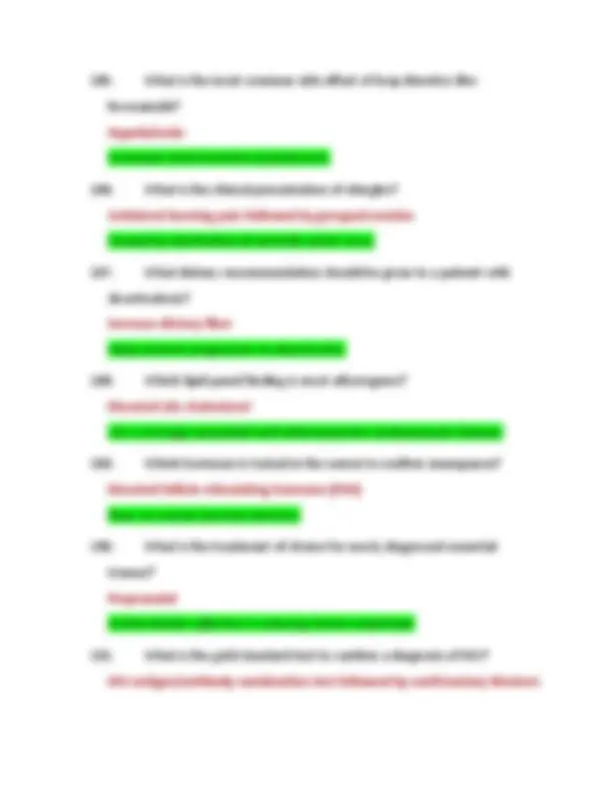
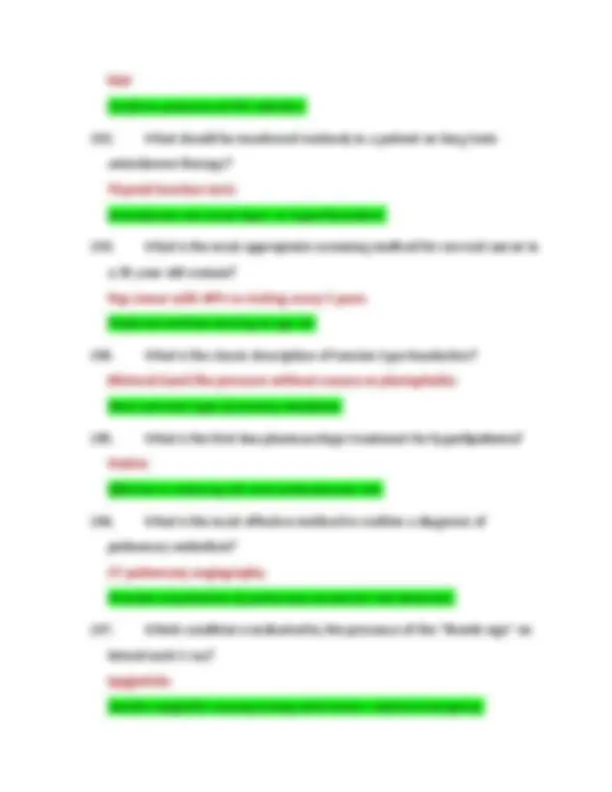
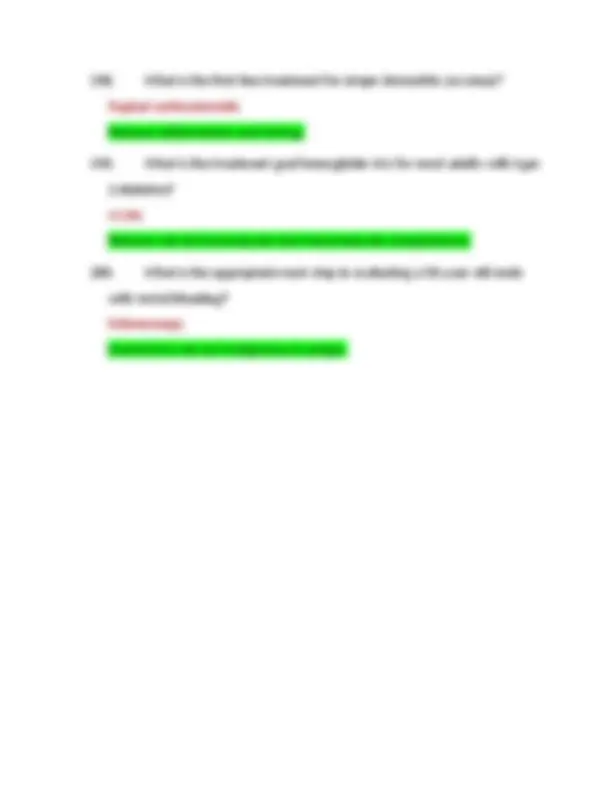


Study with the several resources on Docsity

Earn points by helping other students or get them with a premium plan


Prepare for your exams
Study with the several resources on Docsity

Earn points to download
Earn points by helping other students or get them with a premium plan
Community
Ask the community for help and clear up your study doubts
Discover the best universities in your country according to Docsity users
Free resources
Download our free guides on studying techniques, anxiety management strategies, and thesis advice from Docsity tutors
NURS 5432 FNP 1 |All Exams Study Notes (This document covers the entirety of the class) University of Texas, Arlington
Typology: Exams
1 / 31

This page cannot be seen from the preview
Don't miss anything!
























17.What is the best test to diagnose diabetes mellitus? Hemoglobin A1c ≥ 6.5% HbA1c reflects average glucose over 3 months and is widely accepted. 18.What is the primary treatment for acute otitis media in children? Amoxicillin First-line antibiotic unless allergy or treatment failure. 19.Which vaccine should adults age 65 and older receive to prevent pneumococcal disease? Pneumococcal conjugate vaccine (PCV13) followed by PPSV This sequential schedule provides broader protection. 20.What is the primary symptom of hypothyroidism? Fatigue and weight gain Due to slowed metabolism from deficient thyroid hormone. 21.Which medication requires regular monitoring of INR? Warfarin INR monitoring ensures therapeutic anticoagulation and safety. 22.A patient with chronic obstructive pulmonary disease (COPD) should avoid which medication class? Beta-blockers (non-selective) They can worsen bronchospasm, especially non-selective types. 23.What clinical feature differentiates type 1 from type 2 diabetes? Presence of autoantibodies and insulin dependence in type 1 Type 1 is autoimmune with beta-cell destruction; type 2 is insulin resistance.
24.In which condition is a positive Murphy’s sign observed? Acute cholecystitis Pain and inspiratory arrest during right upper quadrant palpation. 25.What is the first-line treatment for major depressive disorder? Selective serotonin reuptake inhibitors (SSRIs) SSRIs are effective with favorable side effect profiles. 26.What is the typical presentation of rheumatoid arthritis? Symmetrical joint pain and morning stiffness lasting more than 1 hour Chronic autoimmune inflammation affects small joints. 27.Which lab test is used to monitor therapeutic levels of lithium? Serum lithium level Lithium has a narrow therapeutic index requiring close monitoring. 28.What is the typical finding on EKG in atrial fibrillation? Irregularly irregular rhythm with no distinct P waves This reflects chaotic atrial electrical activity. 29.What is the primary cause of iron deficiency anemia? Chronic blood loss Especially gastrointestinal bleeding in adults. 30.Which antihypertensive drug is safest during pregnancy? Methyldopa It has the best-established safety profile in pregnancy.
38.What is the normal range of adult resting heart rate? 60 to 100 beats per minute Rates outside this range are considered bradycardia or tachycardia. 39.What is the most important lifestyle modification to reduce hypertension? Dietary sodium restriction Reducing salt intake lowers blood pressure significantly. 40.Which clinical test is used to evaluate carpal tunnel syndrome? Phalen’s test Wrist flexion causing paresthesia indicates median nerve compression. 41.What is the most common cause of primary hypothyroidism? Hashimoto’s thyroiditis An autoimmune destruction of thyroid tissue. 42.Which lab test is elevated in acute pancreatitis? Serum lipase More specific than amylase and elevated in pancreatitis. 43.What is the antidote for acetaminophen overdose? N-acetylcysteine (NAC) Prevents liver damage by replenishing glutathione. 44.What clinical feature is most concerning for melanoma? Asymmetry and irregular borders of a pigmented lesion ABCDE criteria highlight melanoma warning signs.
45.Which vitamin deficiency causes pernicious anemia? Vitamin B Due to intrinsic factor deficiency leading to impaired absorption. 46.What is the most common presenting symptom of hypothyroidism? Fatigue Caused by decreased metabolism and energy production. 47.Which medication is commonly used for long-term management of chronic stable angina? Beta-blockers They reduce myocardial oxygen demand by lowering heart rate and contractility. 48.What is the hallmark symptom of asthma? Reversible airway obstruction causing wheezing Inflammation and bronchospasm cause variable airflow limitation. 49.Which test is diagnostic for celiac disease? Tissue transglutaminase (tTG) IgA antibodies High sensitivity and specificity for celiac disease screening. 50.What is the first step in managing a patient with suspected sepsis? Prompt administration of broad-spectrum antibiotics Early antibiotics improve survival in sepsis.
57.What is the hallmark physical exam sign of Parkinson’s disease? Resting tremor Typically a “pill-rolling” tremor observed at rest. 58.What medication class should be avoided in patients with a history of angioedema? ACE inhibitors ACE inhibitors increase bradykinin, triggering angioedema. 59.Which laboratory test is used to diagnose iron deficiency anemia? Serum ferritin Ferritin reflects iron stores and is low in iron deficiency. 60.What is the most appropriate initial imaging study for suspected appendicitis in adults? Abdominal ultrasound or CT scan Ultrasound is often first in young adults; CT is more sensitive. 61.Which drug is preferred for treatment of latent tuberculosis infection? Isoniazid for 9 months Long duration treatment to prevent active disease. 62.What is the classic triad of symptoms in nephrotic syndrome? Proteinuria, hypoalbuminemia, edema Loss of protein in urine causes low serum albumin and fluid retention. 63.What medication is contraindicated in patients with severe asthma? Beta-blockers (non-selective) They can cause bronchospasm and exacerbate asthma symptoms.
64.Which vaccination is recommended annually for adults? Influenza vaccine Annual vaccination is required due to changing viral strains. 65.What is the primary treatment for type 2 diabetes in obese patients who also need weight loss? GLP-1 receptor agonists They promote weight loss and improve glycemic control. 66.Which cardiac condition presents with a “machine-like” continuous murmur? Patent ductus arteriosus (PDA) The murmur is due to continuous flow between the aorta and pulmonary artery. 67.What is the recommended antibiotic for Lyme disease in adults? Doxycycline Effective against Borrelia burgdorferi in early disease. 68.Which vitamin deficiency causes night blindness? Vitamin A Vitamin A is essential for retinal function and vision. 69.What is the most common cause of secondary hypertension? Renal artery stenosis It causes increased renin production leading to hypertension. 70.What is the treatment for acute gout attack? NSAIDs They rapidly reduce inflammation during attacks.
78.What is the typical presentation of chronic venous insufficiency? Leg edema with hyperpigmentation and varicosities Poor venous return causes these signs. 79.Which medication class is indicated in heart failure with reduced ejection fraction (HFrEF) to improve survival? ACE inhibitors They reduce mortality and morbidity in HFrEF. 80.What is the diagnostic test for systemic lupus erythematosus (SLE)? Antinuclear antibody (ANA) test Highly sensitive but not specific for SLE. 81.What is the preferred medication to treat osteoporosis? Bisphosphonates They inhibit bone resorption and increase bone density. 82.What is the mechanism of action of metformin? Decreases hepatic glucose production It reduces gluconeogenesis to lower blood sugar. 83.Which vitamin deficiency causes rickets in children? Vitamin D Essential for calcium absorption and bone mineralization. 84.What is the preferred treatment for stage 1 hypertension without comorbidities? Lifestyle modifications Diet, exercise, and weight loss are first steps.
85.Which electrolyte abnormality is seen in Addison’s disease? Hyponatremia and hyperkalemia Due to aldosterone deficiency causing sodium loss and potassium retention. 86.What clinical feature is typical of mitral valve prolapse? Mid-systolic click Result of abnormal mitral valve leaflet motion. 87.Which laboratory test is used to diagnose heparin-induced thrombocytopenia (HIT)? Platelet factor 4 (PF4) antibody test Detects antibodies against heparin-PF4 complexes. 88.What is the treatment for anaphylaxis? Intramuscular epinephrine First-line therapy to reverse airway swelling and hypotension. 89.Which class of antihypertensives can cause cough? ACE inhibitors Bradykinin accumulation causes dry cough in some patients. 90.What is the cause of most cases of iron deficiency anemia in adult men? Gastrointestinal bleeding Chronic blood loss is the most common etiology. 91.What is the clinical presentation of panic disorder? Sudden onset of intense fear with physical symptoms like palpitations and shortness of breath Episodes peak within minutes and are recurrent.
99.What is the most common cause of acute pancreatitis? Gallstones and alcohol These two are leading causes.